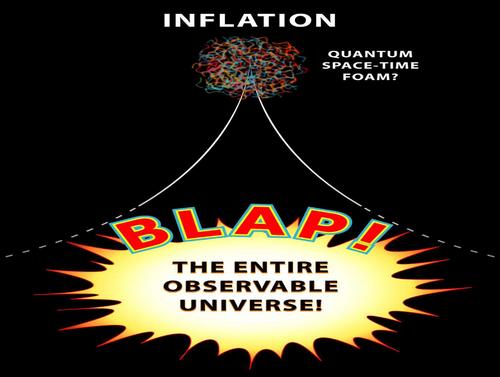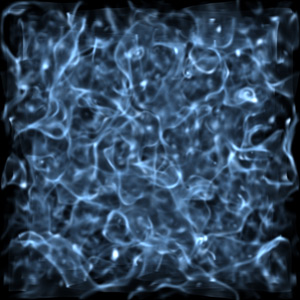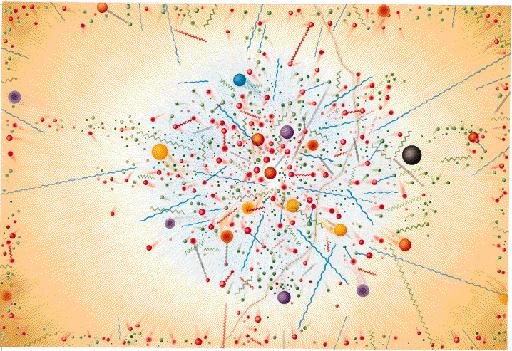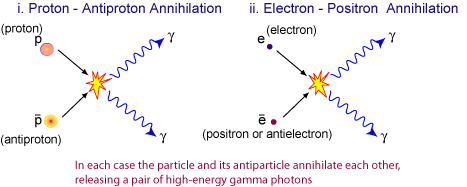Yesterday, I wrote to you about part 5 of The Greatest Story Ever Told, about how the Universe came to have more matter than antimatter in it. And many of you correctly responded that I had given too much detail and not enough explanation.
So, I want to try again for all of you. Here's the explanation, starting at the beginning.

The Universe inflated first, stretching it flat and making it uniform, both everywhere in space and in all directions equally. Then inflation ended, and all the energy that was making it inflate got dumped into particles and radiation. This part, when inflation ended, could be called the "classical" big bang.

The radiation and these particles were incredibly energetic, even compared to anything we've ever created in a laboratory. It was so energetic that there were no atoms, nuclei, or even protons or neutrons. What you need to do, if you want to understand what the Universe looked like at this time, is imagine the tiniest point particles and all of their antiparticles, flying around in great abundance, as close to the speed of light as the conservation of energy allows them. This means electrons, muons, taus, all six quarks, neutrinos, and all of their antiparticles in equal abundance, in addition to whatever else may be out there.

They're also way more abundant at this time -- by about a factor of a billion -- than matter particles are today. But if this was all we had in the Universe -- matter and antimatter in equal amounts -- they would annihilate away (like matter and antimatter are wont to do), until there were so few particles left that they couldn't find each other in this huge and expanding Universe.
But this didn't happen; if it did, only one in every hundred billion particles that exist now would still be here, and half of them would be antiparticles. (This is down by a factor of about 1020 from the particles & antiparticles that existed at the end of inflation.) So something had to have happened that made the Universe choose matter over antimatter, and at the level of about one extra matter particle for every billion matter/antimatter particles out there, otherwise nearly everything would have annihilated away into photons (i.e., light) by now.

So what happened? Well, we know that there are a few constraints between matter and antimatter. First off, if you have an unstable matter particle, its corresponding antimatter particle is also unstable. Because of symmetries between matter and antimatter, they need to have the same total decay rate, which means they need the same lifetime and they need to be able to decay into the opposite, corresponding particles. And finally, whatever it is that they decay into, there is a conservation law telling us that the net number of baryons (protons & neutrons) must equal the net number of leptons (electrons and neutrinos) that you create.
This works out to be amazingly convenient, because we do have a Universe with equal numbers of protons and electrons! But, I wanted to tell you how this happened. There are many different ways, including (here come some scientific names) GUT baryogenesis, leptogenesis, electroweak baryogenesis, and the Affleck-Dine mechanism.
But let's make up a way to do this that's even simpler than any of these, just to show you how this is possible. Imagine that we have a new particle called Y, which is neutral and unstable, and its antiparticle, Y*. This is both necessary and reasonable; in fact, it seems unreasonable to imagine that we've discovered every single particle in the Universe, considering that there's such a significant energy range left to explore.
We need to produce a lepton for every baryon we produce, and an anti-lepton for each anti-baryon we produce. We also have to conserve charge, and we need for the Y and the Y* to allow the same types of decays. The one way they're allowed to be different is known as CP violation, which means that particles can decay through one decay route more frequently than their antiparticles do, and antiparticles can decay through an alternate route more frequently.
So let's say the Universe is full of -- among other things -- Y's and Y*'s. The Y's can decay into either a proton (one baryon) and an electron (one lepton), or an anti-neutron (one anti-baryon) and one anti-neutrino (one anti-lepton). In both cases charge is conserved and we meet our conservation law about baryon number equaling lepton number. What do the Y*'s do? Well, our conservation laws tell us they must decay into either an anti-proton (one anti-baryon) and a positron (an anti-lepton) or into a neutron (one baryon) and a neutrino (one lepton).But remember what CP-violation lets us do: it allows the Y's to decay into protons and electrons more frequently than they decay into anti-neutrons and anti-neutrinos, and it allows the Y*'s to decay into neutrons and neutrinos more frequently than they decay into anti-protons and anti-electrons. It means that if we have a thousand Y's and a thousand Y*'s, 501 Y's can become protons and electrons while 499 become anti-neutrons and anti-neutrinos, while 501 Y*'s can become neutrons and neutrinos, while 499 become anti-protons and positrons. The protons and antiprotons, neutrons and anti-neutrons, and electrons and positrons will all find each other, annihilating away. But what will be left over? Two extra protons, two extra electrons, two extra neutrons, and a bunch of neutrinos and anti-neutrinos.
In other words, more matter than antimatter. I realize this is a difficult topic and I'm sorry I don't have a simpler way to explain it, but that may be because I don't have a simpler way that I understand it. So ask your questions here, and if there are enough good ones that are answerable in a reasonable length, I'll take them on at the end of the week. In the meantime, I hope this clarification helps!





Comments
I just have a quick note. Under the nice picture of the particle soup, you have:
I think that section in parenthesis may need some tweaking.
Otherwise great writeup, I will share it around.
Posted by: Brian H | March 2, 2010 1:47 PM
Thanks Ethan for making this more palatable. Is there a way to predict a Cp violation, or is this an "observable" where we lack a theoretical basis?
Posted by: Mu | March 2, 2010 1:56 PM
OK, so hadronization occurs to the quark/gluon plasma after the BB about 170 Mev and this (thanks) I understand, however hadronization in higher temperatures due to color confinement also occurs combining quarks and anti-quarks. I agree that stabilization would require a cooler temperature but couldn’t hadronization become unequal during high temperature hadronization and so to say set the stage for a later and more permanent hadronization?
OK not experimentally seen as yet, I mean it is a possibility…isn’t it?
I’ve read that electro-weak baryogenisis alone does not provide enough disparity between matter and anti-matter to provide what we see.
“There is currently insufficient observational evidence to explain why the universe contains far more baryons than anti-baryons. A candidate explanation for this phenomenon must allow the Sakharov to be satisfied at some time after the end of cosmological inflation. While particle physics suggests asymmetries under which these conditions are met, these asymmetries are too small empirically to account for the observed baryon/anti-baryon asymmetry of the universe.”
The three conditions that must be met to provide a disparity in baryons/anti-baryons are
Baryon number B violation.
C-symmetry and CP-symmetry violation.
Interactions out of thermal equilibrium.
Andrei Dmitrievich Sakharov
Would not the decay route that you speak of be dependant to an earlier higher temperature hadronization of QGP?
I do understand what you describe and it is very helpful.
If I have missed the mark please correct me.
One more quick question OT (in the picture at the top of the page ) is that a sword or a dagger? I’ve been curious for some time now. Cool pic!
Posted by: Sphere coupler | March 2, 2010 4:09 PM
I know this is a "are we there yet?" question:
Why is there a CP-violation?
Posted by: NewEnglandBob | March 2, 2010 4:45 PM
| March 2, 2010 4:45 PM
just a simple note:
The explanation assumes that the decay rate should be higher than the annihilation rate of the matter and antimatter..the later might be related to the density of matter and antimatter.
Posted by: vaibhav | March 2, 2010 5:10 PM
New England Bob:
I don't understand what kind of answer you're looking for ("why" questions are always hard that way). CP is a symmetry transformation. Either nature is symmetric under this transformation or it is not, and we've seen in experiments (in the 60's for the neutral Kaons, in B mesons at BaBar and Belle more recently) that it is not.
Posted by: Brian H | March 2, 2010 5:54 PM
For people asking about CP violation: As Brian H says, CP is a symmetry which could be a feature of nature but is not formally required and is in fact found to be violated. (Although the symmetry CPT, where T is time reversal, is required for a Lorenz invariant field theory.)
However, CP itself does have some constraints. For instance CP violation in the quark sector can only occur if there are more than two families of quarks. Hence its detection in decays allowed the prediction of a third quark family (bottoms and tops) before there was much independent evidence. Moreover, CP violation could be spontaneous, i.e. CP symmetry could be valid at high energies and hidden at observable scales. This is relevant since certain GUT theories, notably SO(10) necessarily have no CP violation, but it can come in at lower energy scales when SO(10) is spontaneously broken to the Standard Model symmetries than define the known quantum forces.
Also n.b., the equal number of baryons and leptons that Ethan mentions is linked to B-L symmetry. Unless I'm mistaken this is also not in general a logically required symmetry and in fact is probably broken at everyday scales, but it may be restored at GUT scales.(And is also a part of SO(10)).
Posted by: josh | March 2, 2010 7:21 PM
Could you also provide a little background on how we know all this? For instance, how do we know how many particles and anti-particles there were at the big bang, considering that most of them have apparently disappeared?
Also, did we figure out that CP violation caused the imbalance because it fits the number of left-over particles? Or do we know how many particles were left over because it was CP violation causing the imbalance?
Mighty interesting stuff, this, thanks :)
Posted by: Deen | March 2, 2010 8:33 PM
Philosophical point: if things had gone the other way and left more antimatter than matter, we'd still call the more common form 'matter'.
Posted by: djlactin | March 3, 2010 5:26 AM
Matter and anti-matter represent the right-hand and the left-hand universe's annihilation into a state of pure energy creating a "space" as we perceive it. In the "Big-boom" theory, right-hand matter may have started slightly before left-hand matter in the imploding collapse, creating a "residue" of right-hand matter which rules. It's hard to think of matter as residue but can explain why there is proportionally so little of it compared to "dark matter" (unseen gravity force) and anti-gravity or "dark energy" which perpetually creates "space" through its dominance.
Posted by: E. E. Hundt | March 3, 2010 9:01 PM